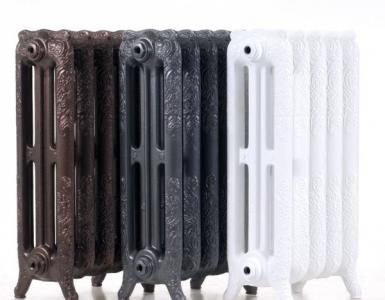Electric heaters for home which are better reviews. The ratio of the cost of the device and its effectiveness. Overview of different types of home heaters
Buying a heating device for your home, many are faced with a huge assortment of them. How to choose the most suitable among the set of devices presented? Which types of heaters for the house are the most economical, and for what purpose are they suitable?
Let's consider the basic types of heating devices, their advantages, disadvantages and methods of use. In total there are four types of household heaters with different operating principles:
- Convectors (,), which work on the principle of convection, moving heated air upwards and sucking cold air from below for subsequent heating.
- , heating the long-wave rays (according to the principle of the sun in nature), walls, floors and various things in the apartment.
- , creating a warm directional air flow.
Oil radiators
Very good for heating a private house or apartment oil heaters, which are quite mobile batteries filled with mineral oil inside. The battery surface is heated by heating the oil, with the help of heating elements (1 or 2 heaters are connected). Such radiators consist of several sections, and the more of them, the more heat is given by such a battery.
When choosing an oil heater for home use, pay attention to its power. Calculation of the required power is as follows: 1 kW can heat the room in 10 m 2 (with a ceiling height of up to 3 m).
Also, oil heaters sometimes have built in fan heaters, which greatly reduces the time of heating the room. The advantages of oil heating devices include:
- The presence of a thermostat, which can regulate the power of the device (if the heater is two, then the knobs of the thermostat must also be two).
- Timer configuration (in most modern models) for setting the on or off time of the installation.
- Relatively low cost.
- Mobility (they can be freely moved around the room or in other rooms).
- The opportunity to work for a while without consuming electricity (due to the already heated oil, which is very slowly cooling down), which can give tangible savings.
The shortcomings of this type of household heaters include:
- Long heating (which is compensated by slow cooling).
- Considerable dimensions and weight of the device.
- Strong heating of the housing surface (however, most models are equipped with a special protective cover for safety reasons).
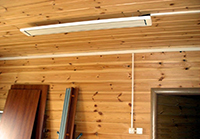
Convection heaters
Convector facilities are divided on different grounds. For example, they can be classified by type of installation:
- , easily moving in any direction.
- (vertical, horizontal), characterized by a small thickness and attractive design. They can be mounted under the window, similar to batteries.
- Ceiling. They can be mounted like a wall.
- . They are often mounted simply in the floor to improve the uniform heating of the entire room. To do this, it is necessary in advance to lay in the floor niches for laying pipelines supplying hot heat carrier. From above, such convectors are covered with a beautiful grille for penetrating warm air.
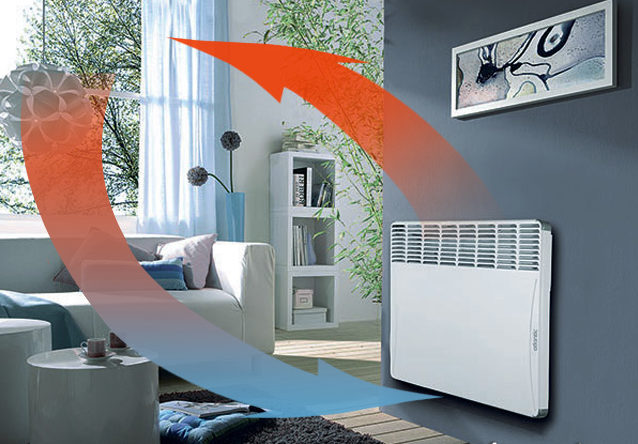
They are also shared by type of heating:
- Water. Require sometimes special installation boiler and pipelines.
- Electric. The simplest and quickest in heating devices are easy to install, do not require additional installations.
- Gas. In residential buildings are rarely used.
And even by type of circulation:
- Natural, based on simple convection.
- Forced, with built-in fan for better and quick warm-up.
Advantages of convection type heaters include:
- Noiselessness in work.
- The temperature of the shell is usually not higher than 60-65 degrees, which makes them sufficiently safe.
- Built-in to adjust auto self-shutdown and turn on.
- Built-in emergency protection against overheating.
They are convenient to use. The most convenient of them are floor convectors. They are quite mobile, they can be freely moved to the right zones. The main thing is that the length of the electric cord is sufficient, since all of them work from the network.
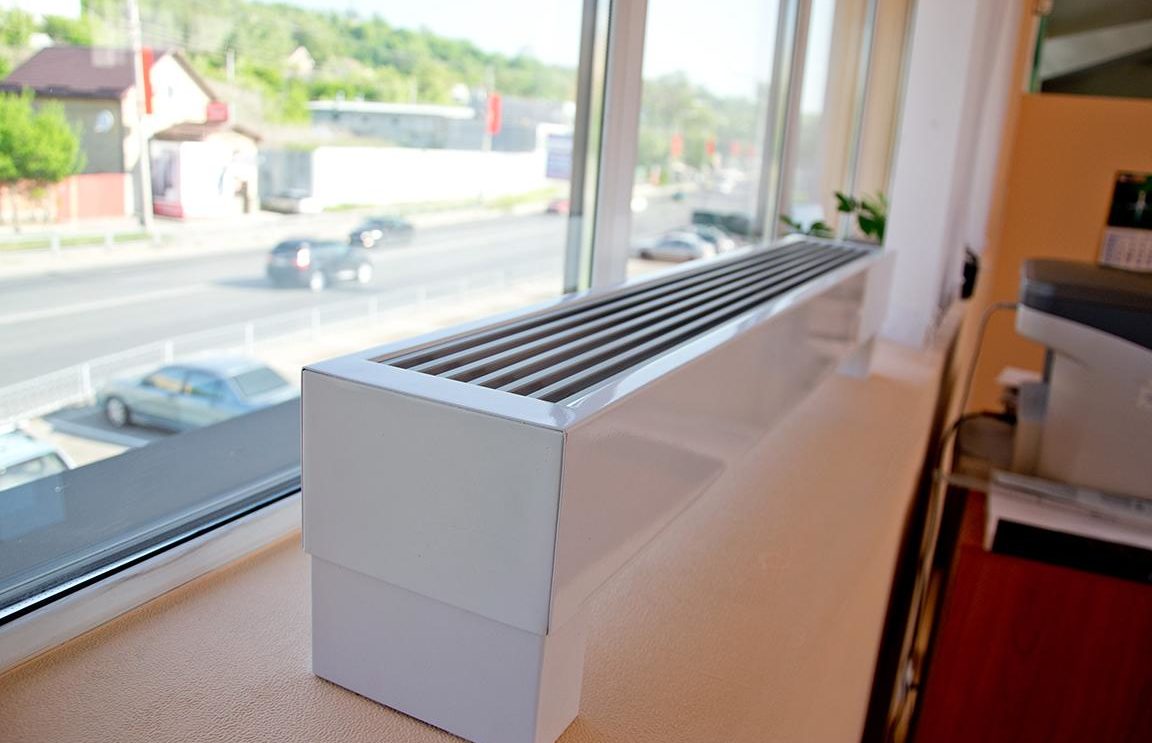
They are sometimes difficult to install. Electric, water and gas convectors are often an alternative to a central heating system. For them, as a rule, provided for special installation (especially for water and gas), implying the installation of a boiler, piping and ventilation ducts.
Electric heaters convector type is difficult to heat large rooms.
Infrared heating units
These types of electric heaters contain inside the case special lamps:
- containing a tube with a thread filled with an inert gas.
- , having threads of carbon fiber.
- with tungsten filaments.
These lamps are capable of emitting long-wavelength infrared rays, invisible to the human eye. From them, as well as from the sun (by analogy with nature), all the objects in the room (floors, walls, furniture) are heated, and then the air. In their execution, these heaters are:
- Ceiling.
- The wall.
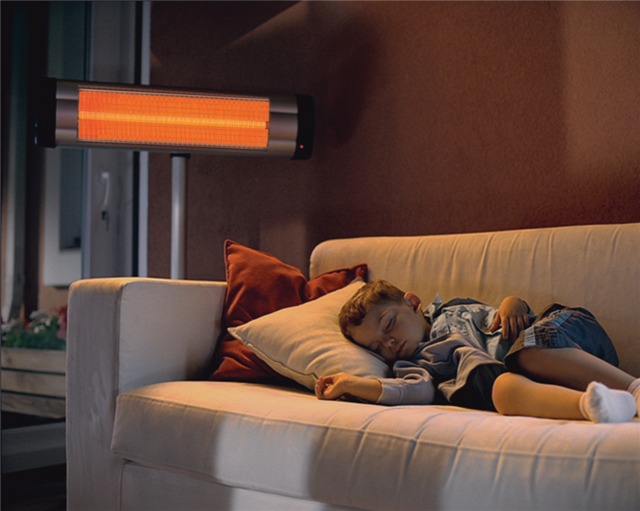
They can be installed not only in living rooms, but also if necessary on balconies, terraces, greenhouses, etc.
Advantages of infrared heaters:
- Noiselessness in work.
- Economical energy consumption.
- The ability to heat without raising dust in the air.
- Devices do not overdry air and do not burn oxygen.
- Uniform heating of air in the whole room (for more details on the scheme of work - in the article).
- When the device is turned on, the room starts to warm up instantly.
The shortcomings of these devices can be attributed only to their rather high cost.
Fan heaters
The most affordable and easy to use are thermal fans, which are usually desktop or floor. When air passes through the heating elements of the device, quick warm-up any room. The heating elements in the fan heater are made in the form of:
- Electrical open spiral with a temperature of up to 800 degrees.
- An electric heater in the form of a tube with a temperature of over 200 degrees.
- Ceramic tiles with a temperature of up to 200 degrees.
Thermal fans with ceramic heating elements provide more clean air supply, without the release of combustion products. Appliances are popular because of their low cost and ease in carrying. They almost instantly heat the room to the desired temperature.
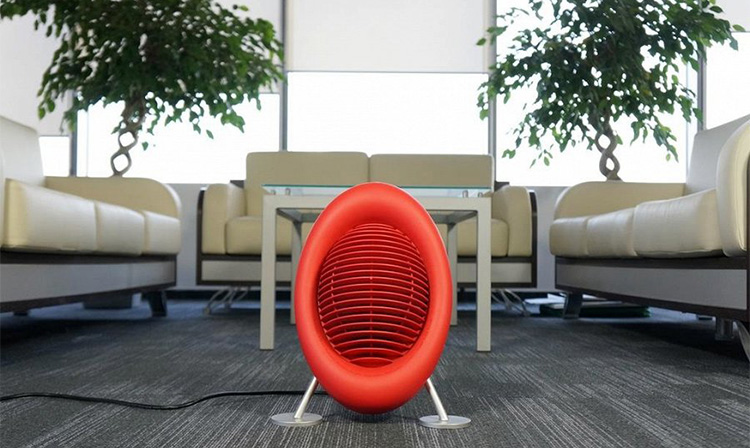
Fan heaters are economical: 1 kW of power of the device can warm the room up to 20-25 m 2.
In addition to these characteristics, their merits can be thermostat, which instantly turns off the device when it overheats.
The disadvantages of thermal fans include their noise and the ability to pick up dust in the room.
There is still such a kind of heaters, like blowers or. In the system of such heat-waves, heated spirals and a powerful fan are involved. Blowers are very effective in unheated rooms, for example, garages.
Conclusion
Among a huge number of different types of heaters for an apartment and a house, you can always choose the device that most satisfies all the requirements, if you know all of it specifications, advantages and disadvantages. He not only warms up the room, but also gives him comfort, creates the necessary microclimate in the room. The main thing is to balance the price with quality, capacity with heated area, and ease of use with ease of maintenance of the device.
One should not think that electric heaters for a house are needed only for those who lack central, gas and stove heating. Batteries do not become warm immediately after the onset of colds, and heating season have to wait in cold rooms. In this situation, the heater for the apartment is the only way to create comfortable living conditions. This device does not have to work daily from October to April, so many do not attach much importance to its efficiency. However, with the constant use of electrical equipment for heating, efficiency comes to the fore.
One should not think that electric heaters for a house are needed only for those who lack central, gas and stove heating
Buying those or other units for heating, in the first place it is necessary to assess how safe they are in operation, and only after that give preference to the most economical electric heaters. If in the instructions to the device there is a note: "Do not leave unattended", it can not be used as the only source of heat in the winter. But even heating devices that are under constant supervision must meet all the requirements of electrical and fire safety.

If the family has a small child, it is advisable to dwell on models that exclude the possibility of getting burns. At night, one of the main requirements is the noiseless operation of space heaters. If you need to move the device from room to room frequently, its weight becomes an important factor. It is necessary to take into account the speed of entering the operating mode, that is, the time required for heating up to the optimum temperature. Until it is reached, a fairly high consumption of electricity occurs. Therefore, with a short work (within 1-3 hours) to use units with a long period of output on the active indicators is irrational.
How to choose a heater (video)
Which is better: a convector or an oil cooler?
Modern oil unit in comparison with its predecessors is devoid of such flaws as excessive heating of the radiator housing. This avoids burns if accidentally touched. But even such an economical heater as the model Electrolux EOH / M-6209, weighs about 9 kg, and heats up to the set temperature of about 15 minutes. At the same time, after entering the active mode, the unit shows an excellent ratio of power consumption and heat output. It is advantageous to use it for heating the premises for a long time, rather than a few hours a day.
Many complaints in due time caused models, which in some cases could literally "explode" and pour hot oil on floors and furniture. New models are safe in operation and do not have such drawbacks. They are equipped with a sensor, due to which the overturned device is automatically switched off. They have protection from splashes and from overheating. The most economical heaters are equipped with a timer that turns on the device at a specified time.

This allows you not to use the unit "idle" when no one is home. Despite the fact that some models weigh more than 20 kg, they are easy to move thanks to the wheels and a comfortable handle.
Convectors are safe enough that they can be left on and unattended. They are devoid of oil filler, which eventually begins to flow if the device does not have a protective casing. Tan (heating element) heats directly the body of the convector. The risk of burns is absent, since the outside temperature is not more than 60º. Thanks to a small mass and a flat surface, the electric heater can not only be installed on the floor, but also hung on the walls. Heat from the unit comes through natural movement air masses different temperatures (convection).
The principle of operation of both types of devices is such that they raise dust into the air even without fans, but oxygen is not burnt at all, since they do not have open filament spirals. Comparison of cost different types heaters on the site of the virtual hardware store "5 element" testifies in favor of units with oil filler, however their efficiency is lower than that of convectors. Heat output can only increase the built-in fans, and they create additional noise.

Buying these or other units for heating, in the first place it is necessary to assess how safe they are in operation
Inverters or simple fan heaters?
The spiral of the fan heater is almost instantaneous. The air pumped through it quickly heats up and fills the room with heat. On sale it is possible to find absolutely small portable devices, something resembling a usual hair dryer. They weigh very little, and are inexpensive. However, the device consumes a lot of energy, the fan runs quite noisily, and when oxygen passes through the spiral, oxygen is burned. The cheapest models quickly fail. As a dacha option, the fan heater is convenient only when it is required to warm up quickly, but it is not designed for long-term operation. If the unit is turned off, the room will cool down very quickly, so it is by no means the most economical heater.

The spiral of the fan heater is almost instantaneous. The air pumped through it quickly heats up and fills the room with heat
It turns out that if you convert (invert) alternating current, coming from the mains, into a constant current, simultaneously changing its frequency and voltage, it is possible to significantly increase the power of the device built on this principle. The inverter heater is equipped with a fan, but it works much quieter, and consumes 40% less energy than conventional units. The main advantage is that when the set temperature is reached, the most economical device continues to operate at minimum revs. This avoids large energy costs during the next turn-on. The operation of air conditioners, which are sometimes used for heating residential premises, is based on the same principle of operation.
Infrared rays
The sun heats the earth, and it, in turn, gives heat to the air. Due to the movement of warm air masses, the surrounding space is warmed up. In the same way, the IR heaters are electric. They emit infrared waves, the parameters of which are comparable with the long-wave spectrum of solar radiation. Influence of infrared waves has a beneficial effect on the human body. They deeply warm up muscle tissue and improve well-being. The most efficient heater, based on infrared radiation, almost instantly creates a comfort zone even in a very cold room.
Depending on the size of the apartment you can choose the most suitable model. So, the infrared electric heater Camelot is able to heat the area up to 40 m². For smaller rooms, TermoPlaza and UFO are more suitable. All units are available in different versions - floor, wall, ceiling, portable. The installation of devices is so simple that it can be carried out even without the call of a specialist. To economical heaters for giving special requirements. After all, they are installed not only in the premises, but also on open verandas.

Due to the directed effect, heat is not dissipated, but concentrated in that part of the space where it is needed.
Well-established recently appeared carbon units. In them, infrared radiation is generated not by a tungsten spiral, but by a carbon (carbon) filament. The rays warm up surrounding objects to a depth of 2 cm, so even after turning off the device, heat transfer takes a long time. To understand which heater is more economical: oily or carbon, it is enough to compare only 2 parameters. With a power input of 1 kW, the heating area of the oil meter is 10 m², and the carbon unit is able to service a territory of 30 m².
The advantage of modern infrared heaters lies in the local effect. They create comfortable conditions in a small area, without dissipating heat in an unused part of the room. However, this is also their drawback, as the room warms up unevenly. Another disadvantage is the high cost, although devices with a carbon filament are cheaper than with a tungsten spiral.
Which heater is better (video)
Combined impact devices
To avoid the occurrence of too cold or hot areas in the premises allows a combined method of heating. In this case, infrared waves do not affect objects directly. They heat the ceramic heating panels, and already they transfer heat to the room. The combined instrument consists of several layers: a metal case, heating element and plates from heat-resistant ceramics.
The temperature of the inner surface of the plate is 80-85 ° C, whereas outside it does not exceed 70 ° C. Ceramics excellently accumulates heat and is capable of giving it for a long time even when the device is switched off. If the house is equipped with a multi-zone electricity meter, the unit timers can be adjusted so that infrared ceramic heaters are switched on during the cheapest price of the tariffs. The panel is equipped with a programmable thermostat, which allows you to save energy significantly, and the "child lock", thanks to which electric heaters have become completely safe.
A similar device has an assembly in which the internal surfaces of two panels simultaneously heat simultaneously. One of them is ceramic, the other - steel, which has a special coating, which can accumulate heat. This device is called a bio convector. Its steel component, serving as an air intake, is heated from the backside to 90ºC, which causes active natural air convection. Heated from the inside up to 80º C the panel made of ceramic stone becomes the source of infrared radiation.

Which heaters are the most economical and efficient? Most experts prefer infrared devices with a ceramic panel. They provide a quick and uniform warm-up of the room, do not dry the air, do not burn oxygen and do not cause the movement of dust particles. Modern devices with a high heat-transfer coefficient consume much less electricity than traditional heaters. The thermoregulation system and the timer allow to further reduce energy costs. The cost of the unit is not very low, but it has a high level of security and is able to work without repair for several decades.
Newest developments
For a new generation of plasma heaters, a special heat source was developed. Generation of infrared rays is due to resonant vibrations of silver molecules on the surface of the "glass" screen. After the glass warms up to a certain temperature, it starts to give off heat itself, and the consumption of electricity from this point is significantly reduced. Created on the basis of applied nano-technology, the device emits heat at an angle of 180º, which contributes to its uniform distribution.
Plasma devices do not burn oxygen and do not dry air, but help fight the dampness of the room and fungal microorganisms. The wavelength and other physical characteristics of the radiation of modern heaters coincide with those of the sun, so the instruments are absolutely safe and do not pose a threat of fire. They do not interfere with sleeping, since they operate silently and are not sources of visible light. When replacing traditional heaters with "plasma", the economic effect reaches 65-70%.
The safety system of the device is equipped with a protection against overheating and a sensor that fixes the integrity of the glass. It is possible to program the temperature and the heating mode. Ceiling and wall heaters are easy to install, because they weigh no more than 5 kg. The floor version is equipped with wheels for transportation to another room, a system for changing the angle of inclination and vertical movement of the screen. Economical electric heaters of plasma type outwardly resemble already become habitual liquid crystal monitor or TV. They are accompanied by exquisite design, patterns on the glass surface, built-in FM radio and MP-3 player, which gives a homely backlight system. The only drawback of plasma aggregates is the high price.

Value of the device and its efficiency
If the need for additional heating occurs infrequently and for a short while, you can stop at an inexpensive device. But for a long work, and in particular as the main source of heat, it is better to still purchase electric heaters of a new generation: economical, though expensive. High equipment costs will soon pay off, and its reliability will not allow additional funds to be invested in maintenance and repair.
With an economical heater for your home, you can save 60 to 80% of energy. After all, it is not necessary to heat the entire room around the clock. During the day, the device that has heated up during the night and has already been disconnected can maintain a comfortable temperature for a long time. Thanks to the timer it can be set up so that it is switched on in the last hour before going up or coming in from work.
As a local source of heat, where most family members are most likely, you can use efficient, but extremely economical film type heaters. Their mass is only 300-400 g, and the power consumption is from 250 to 400 watts. They hang on the wall like ordinary paintings, but thanks to infrared radiation they can sensibly heat the room in the zone of their impact. If necessary, the film device can be rolled up and sent to the pantry for the summer.
Thus, the best heater is a safe device that allows you to save energy significantly. This occurs, both due to the design features of the housing and the heat source, and due to the use of additional functions of the device. If it is required to organize a system of constant and uniform heating of the entire room, it is more rational to use ceramic panels that accumulate slowly, but retain heat for a long time. For the creation of temporary comfort zones, the rapidly warming devices that emit infrared waves are more suitable.
And a little bit about secrets ...
Have you ever experienced unbearable pain in your joints? And you do not hearsay what it is:
- impossibility to move easily and comfortably;
- discomfort when climbing and descending the stairs;
- an unpleasant crunch, a snap not at will;
- pain during or after exercise;
- inflammation in the joints and swelling;
- unreasonable and sometimes unbearable aching joint pain ...
And now answer the question: are you satisfied with this? Is it possible to endure such pain? And how much money have you already "merged" with ineffective treatment? That's right - it's time to finish with this! Do you agree? That's why we decided to publish an exclusive interview with Professor Dikul in which he revealed the secrets of getting rid of joint pains, arthritis and arthrosis.
Attention, only TODAY!
To have an additional source of heat is prudent.
In the off-season, heating sometimes can not keep up with the temperature changes outside the window.
There are also emergency situations and accidents, when residents of well-equipped houses start to freeze in their apartments.
In a private house, sometimes the heat is distributed unevenly and there is a need for warmth in some particular room. And in the country, the main heating device can become electric heater. Which is better to choose, what to look for, and what is better - oil or convector.
Heaters differ depending on the method of heat transfer, and in different circumstances their strengths and weaknesses manifest differently.
The choice usually comes down to four basic options:
- Oil.
- Convector.
- Infrared.
- Fan heater.
 Sometimes a heater is just necessary, but it is not always possible to find a place for this device. In this case, he saves. For an overview of models and prices, please visit our website.
Sometimes a heater is just necessary, but it is not always possible to find a place for this device. In this case, he saves. For an overview of models and prices, please visit our website.
Choose gas heater for the tent will help you.
Perhaps the following article will be interesting for you:. Ceramic heaters - the features of choice, pluses and minuses.
Convectors and fan heaters
Rapidly heat the air, mix the flows, evenly warming the room. They are safe and durable, the body is not hot, can be attached to the wall and placed on the floor, compact and light.
Fan heaters are very loud, but they are the smallest, they are easy to carry, rearrange from place to place.
However, someone may not like the constant fan noise and strong air movement. In addition, in order for the room to be warm, the appliance should always work. It does not accumulate heat by the housing and when it is turned off, heat loss immediately stops.
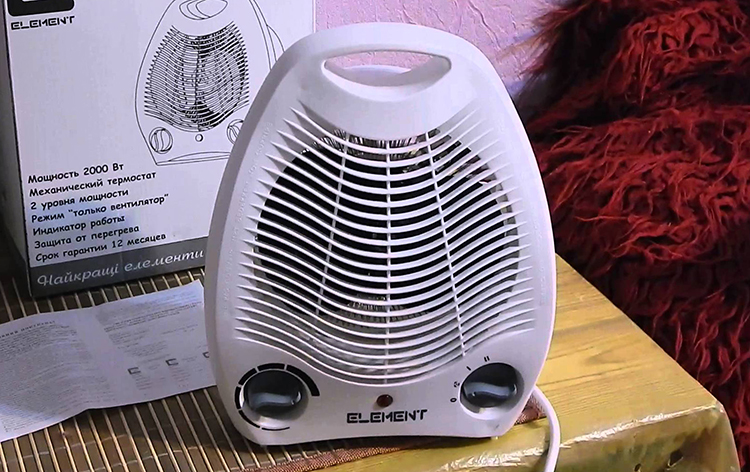
Fan heater
If a person living with an allergy and lung diseases lives in the house, it is better to refuse to buy a fan heater. But for the children's room - the convector is preferable, because it is the safest device.
Infrared heater
"Homemade sun," as it is sometimes called, instantly heats people and objects located in the zone of infrared rays. However, the action is local, therefore as a device for heating the entire room, the IKO is not very suitable.
In addition, users note that after a night's sleep in a room where the IR heater was turned on all night, there is a headache and lethargy.
The most successful application was found by many owners, placing a heater near the table to warm up during work, above the bed (briefly turned on at bedtime to warm the bed), in the kitchen, etc.
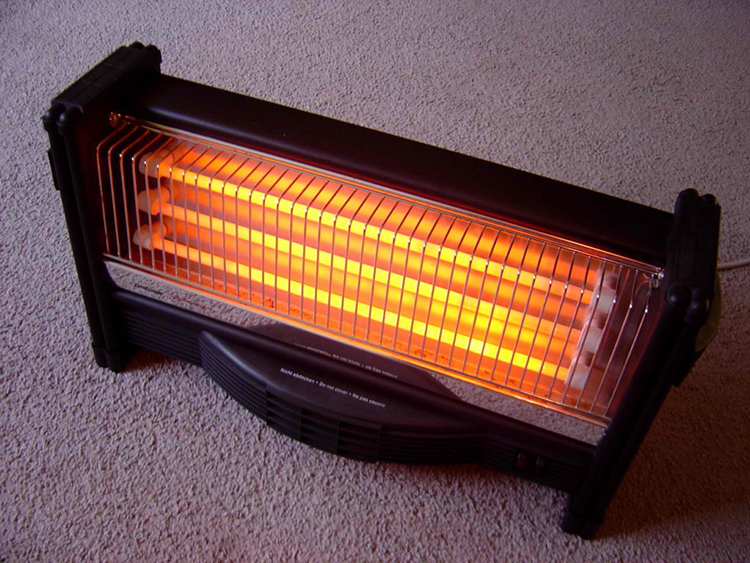
Infrared heater
Oil radiators
Remain in demand among those for whom the movement of air through the apartment is a decisive undesirable factor. They are heavy, do not lend themselves to repair, have a certain expiration date, after which, and with improper use, there is a possibility of an explosion (it is important that the thermostat is serviceable, since most accidents occur precisely because of overheating).
But if you follow all the rules and regulations, you can give warmth, instead of battery. The appliance is heated for a long time, but it also cools down for a long time.Does not dust, it works noiselessly.
The oil heater housing is heated to dangerous temperatures. In addition, it can not be dropped. Therefore, it is better not to put it in the nursery.
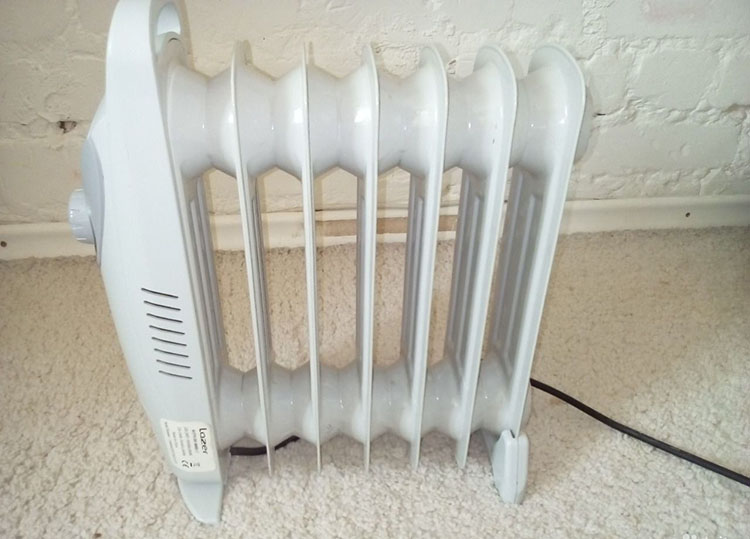
Oil type heater
Which heater is best for giving
The specificity of a cottage is small rooms and the need for quick warm-up. From this point of view, all variants are suitable for a dacha, except oil:
- fan heater;
- convector;
- infrared heater.
In addition, the dacha is rarely installed in a stationary heating system, the heater often arrives and leaves with the summer residents.
So, it should be easy and mobile (this factor should be taken into account when buying, because inside the species there are bulky and compact models), again the oil cooler does not fit, because it is the most weighty and large device.
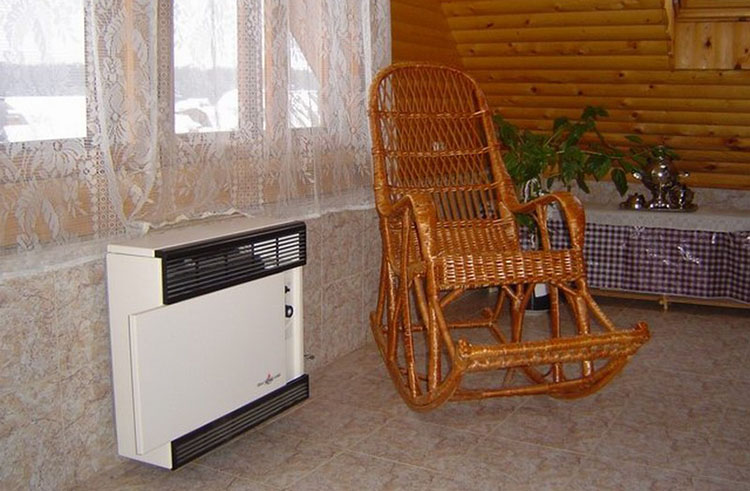
Heater in the country
Any heater must be properly selected: its power must match the area of the heated room. For a well-insulated structure, 1 kW of power is taken per 10 m 2 of area.
Convector or oil heater
We perform a comparative analysis of the characteristics to determine in which situations, which of the options is better:
- Heating rate. The oil is inert - it is heated for a long time, but it continues to radiate heat for some time after switching off. The convector heats the air very quickly, and where quick warm-up, there is energy saving.
- Appearance and installation.The oil has wheels, looks like a battery, bulky, weighs 6 - 10 kg. The convector can be wall-mounted and floor-standing. Flat housing with grilles in the upper and lower parts. Lighter (4 - 6 kg).
- Safety, precautions.The oil has a hot body, you can not dry things on it. To be afraid of overturning (should only work in an upright position). It is best not to leave unattended and protect from children. Against the threats there is a system of protective sensors and relays (not in all models), but if any of them fails, there is a risk of overheating and explosion. Manufacturers indicate their expiration date for their products. And for an oil device - it's not just numbers. Do not use the device for longer, since after this time, the danger of explosion increases (usually 5 to 7 years). At the convector, the housing has an acceptable surface temperature. It is fireproof, not afraid of overturning, does not require constant monitoring by the person. Many models are also equipped with various sensors and relays, most modern models are not afraid of dampness and can be used in wet rooms. The shelf life of convectors is practically unlimited. Usually it is indicated 10 - 15 years, but you can use it until the device breaks.
- Price. Oil Heaters usually slightly cheaper than convection analogues.
Summing up, we can say that the convector unconditionally wins at oil appliances for safety, economy and speed of heating.
The only drawback - the speed of the air through the apartment, but in some models, the fan can be turned off.
Which infrared heater is best
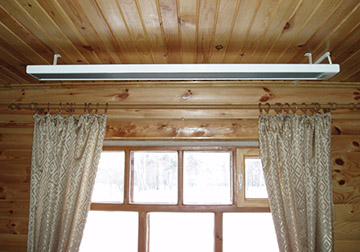 Infrared heaters - this is not something "new", as marketers sometimes position them, spiral IR emitters were produced in Soviet times.
Infrared heaters - this is not something "new", as marketers sometimes position them, spiral IR emitters were produced in Soviet times.
However, since then the devices have been significantly modernized and modified.
The most important factor, which is advised to pay attention when buying, is the wavelength:
- short (up to 2.5 microns);
- average (2,6 - 50);
- long (51 - 2000).
Infrared rays "are located" just behind the red visible light, to microwaves and radio. They are invisible to the human eye, but carry heat in themselves, like sunlight (but remembering that sunlight also contains useful and harmful rays, you need to understand how the IR radiation affects the body).
Short and medium waves are the hottest spectrum. They are used in industrial heaters and street poles - umbrellas. Heat from them is intense, but it is not recommended to stay under it for long, short waves penetrate deeper into the body, which is undesirable. The skin due to them can blush and become blistered. It is especially important to protect eyes from such rays!

The principle of the IR-heater
The long-wavelength radiation is close to the natural radiation of the human body itself. Completely absorbed by the skin (its uppermost layers) and does not cause burns, since their temperature is minimal. Such waves are widely used in medicine, because they are useful and have some disinfectant properties.
For long-term use in the home, purchase only appliances with long-wave radiation. To turn the IR heater into a source of useful procedures, do not sit too close to it, do not stay under it for long and avoid direct exposure to the exposed skin.
Also, IR heaters work on a different kind of energy, which can be a key plus for country houses without electricity. They can work for:
- Electricity.
- Solar oil (diesel engine).
- Gaza (there are for the main gas and balloon).
The choice to make is not difficult, if some fuel is more accessible to others.
Fitting location:
- Ceiling.
- The wall.
- A film "warm floor".
- A separate device, which can be placed on the floor, on a table or bedside table.
A ceiling variant of a lamp or film type is an ideal device for installation in large rooms with a distance to the floor of 3 meters or more. Such models are often installed in garages, services, warehouses, gyms, medical offices, etc. In addition to the fact that the heating is uniform, the place is saved and there is no fear of rapid weathering, if people often walk in a public place, doors open and close.
Wall models are flat heaters, which can outwardly resemble a picture, a panel or a poster. There are also film variants.
The warm floor is the thinnest film (the same is mounted on walls and on the ceiling), which can be placed under the carpet.
Separate heaters can be very different.
Pay attention to instruments that are adjustable in height, and with a rotating radiator. They exclude local overheating, evenly distribute heat.
conclusions
For a small villa it is better to buy a small fan heater or a portable convector. They are more preferable for children's rooms.
In larger houses it is possible to install a stationary convector or IR heater of any type. An oil cooler should be purchased only if other options are not suitable for some reason.
Video on the topic
The cold season is coming, the days are getting shorter, and the house gets colder every day. At this time, you have to think about the need to warm up at home or at work. One of the best solutions that you can take in this situation is to use a heater, having previously found out which heater to choose for the house. Manufacturers of these household appliances are releasing more and more new models, and to choose among them anything concrete becomes more difficult. Below are recommendations on how to choose a heater for your home.
What is a heater
The whole meaning of this device can be understood from its name. Heater - he heats, thus fulfilling the only function assigned to him. Electric heaters can be used in an apartment or a private house, in the country or in the office. They are quite effective and simple, and the electrical power of the devices allows them to compete on an equal footing with gas heating.To distribute heat in heaters, the principles of forced or natural circulation. In addition, they can dissipate heat by combined circulation or using radiation. Later models of heaters can not only increase the temperature of the air in the room, but also carry out cleaning or moisturizing. As a rule, such a wide range of works are performed by universal thermal fans, with which it is possible to dry wet plaster, wet laundry and at the same time to warm the room.
The most common misconceptions when choosing a heater
Consultants in household appliances stores are required to sell as much goods as possible - this is their job. Not surprisingly, when working with a client, consultants use standard, most profitable phrases, which often prove to be nothing more than a trivial invention.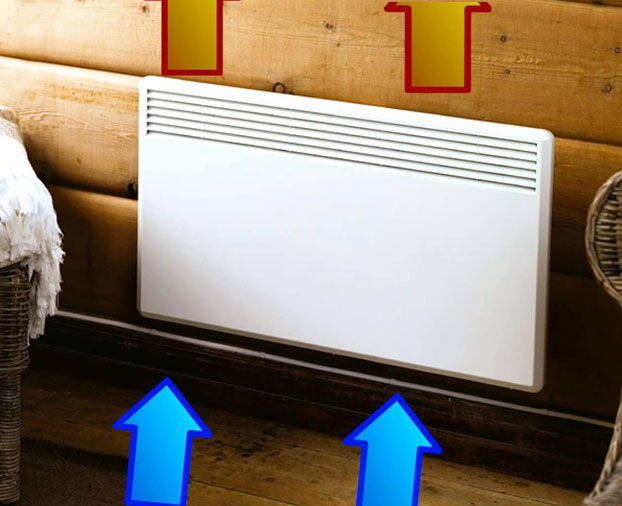
For example, "this heater model does not dry the air". Air is dried by any heater: when the air temperature rises, the humidity of the air decreases proportionally. The expression "this heater provides a much greater efficiency" is also far from the truth - a heater of any type and brand uses the maximum of the energy received and turns it all into heat, so it is impossible to talk about the loss of heat or energy. The myth about the "heater that burns oxygen" is also far-fetched, because oxygen can be burned out with an exceptionally open flame, which simply does not exist during the operation of electric heaters.
How to install a heater
The choice of a heater, ideally suited for all parameters, is a rather complicated task. There is a bundle of parameters, such as "installation method - heater type". That is, when choosing a model, you should immediately think about how it will be located. For greater clarity, you can see the photo, which shows different installation schemes.Stationary heaters can be installed on a wall or ceiling. Typically, these models look quite aesthetic and will not spoil the overall picture. Installing the heater on the wall usually involves creating a certain angle of the device and having a small gap between the body and the wall, which will further simplify the care of the heater.
Heaters designed for horizontal or vertical installation, almost do not take up space, because they can be installed on almost any free patch. There are heaters that are designed for installation under false ceilings. Floor versions are often equipped with wheels or legs.
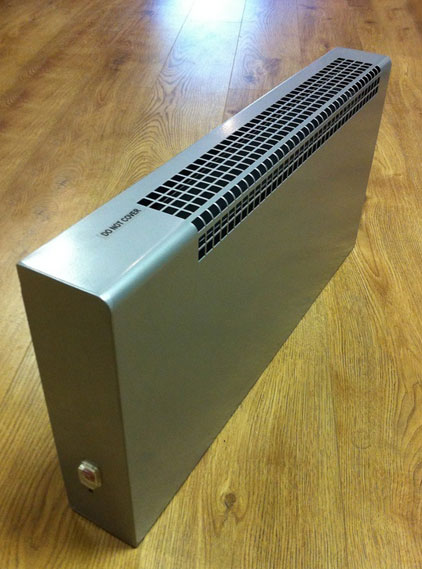
Portable heaters are excellent for permanent relocations or for use in a removable dwelling. Such models are characterized by their compact dimensions, small weight and pleasant appearance.
What does the power of the heater affect?
Power - this is the basic parameter, on which the heated area will depend. An approximate calculation shows that 1 kW of power heats about 25 m3 of space (provided there are no other kinds of heating and good thermal insulation of the room). When calculating the power for a typical apartment, the ratio is 1 kW to 10 m3 with a ceiling height of about 2.5 meters.The presence of central heating naturally reduces required power heater. As a rule, the capacity of 1-1.5 kW perfectly heats the 25-meter room. The latest models of heaters are equipped with thermostats, allowing you to keep the preset temperature regime. A small shortage of thermostats: the absence of a degree scale, which allows you to set the temperature, relying on the sensations.
Classification of heaters
As a rule, heaters are classified according to the operating principle and method of attachment. To choose a suitable model, it is necessary to take into account some parameters: what area should be heated, how the device will fit into the interior and for how long its operation is calculated. Manufacturers produce different types of heaters, and only the right choice will allow the air in the room to warm up to an acceptable temperature.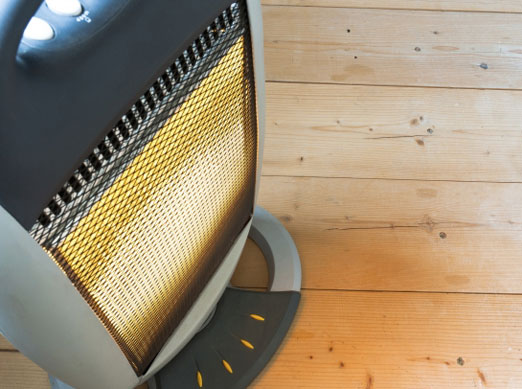
Oil radiator
Perhaps, oil heaters for home can be called the most popular. The rated power varies from 1 to 2.5 kW. In a hermetically sealed case, filled with oil, there is a spiral, the heating of which leads to the release of heat to the oil. Hot oil, in turn, transfers heat to the hull, from which heat dissipates through the air.Oil heaters are well suited for heating apartments or cottages. When the temperature reaches a certain temperature, the heater automatically turns off, and when it falls below a certain threshold, it starts up again. The temperature of the radiator housing does not usually exceed 60 degrees Celsius. Cons of such a heater: a fairly large body and a long warm-up time.
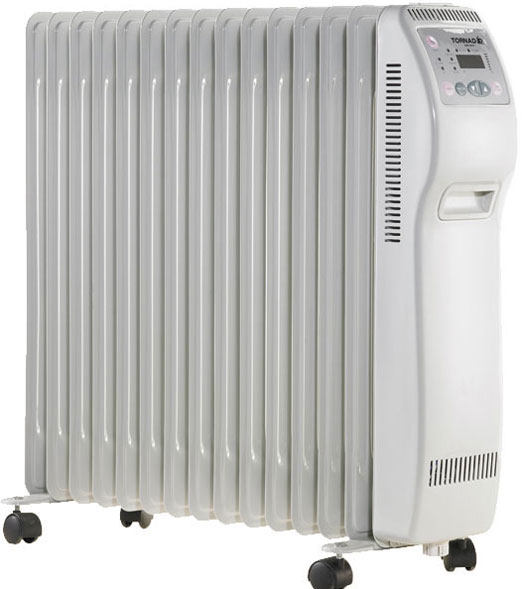
Electric convector
Visually and for their performance, convectors strongly resemble oil heaters, but are much better suited for installation as central heating. This type of heater can be used in any room. This device is quite unpretentious, does not fear moisture and works perfectly without grounding, which makes it possible to use it around the clock (read: "").The principle of operation is based on the movement of air through a special heating element. The constant movement of air is due to the fact that the cold air is always below the warm air. From here it is possible to deduce helpful advice: the lower the convector is installed, the higher temperature it can provide (read also: "").
Thermal fan
This type of heater belongs to the budget category. As a rule, fan heaters are used for rapid heating of air in small isolated rooms. Such devices differ in small sizes and are equally well placed both on the floor and on the wall. The fan heater is the best answer to the question of how to choose a heater for the room.The air that gets into the fan heater gets warm, getting heat from the hot spiral, then it spreads around the room under the influence of the fan. For better heating, the fan can be rotated. Thermal fans very quickly heat the air, and spread heat fairly well throughout the given volume. The built-in thermostat allows the device to work automatically. Disadvantage: quite loud noise, issued when working in fast mode.
Infrared heater
IR heaters are the most modern heaters for home. Such a device is better to use as a temporary heater, despite its economy (read: ""). The principle of operation of this type of heaters differs significantly from all previous ones: infrared devices do not heat air, but objects that fall into the "hit zone". A working IR heater is similar to a local sun, heating everything it reaches.This type of heater is very economical due to its versatility, does not create any emissions into the environment and allows to completely eliminate the risk of detonation natural gasbecause it is not needed for functioning.
Which heater to choose for home
The choice of heater requires attention to the following nuances:- presence of a serial number of the goods;
- electrical contacts must be intact and reliable - cases are known where a short circuit occurred due to poor contact;
- the wiring of the device should also not cause doubts about its quality;
- it is necessary to check the quality and good performance of the heating element;
- the plug of the wire must be made of high-quality materials and equipped with a grounding terminal;
- if you can not check any of the previous items, then you should make sure that you have a quality certificate - in this case, the risk of acquiring a bad product is almost zero;
- on the body of the product or packaging must be marked with European quality CE, which confirms the safety of the use of this device.
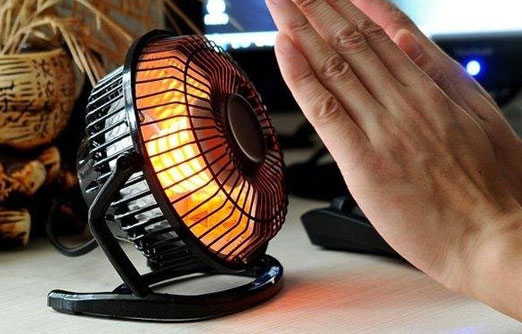
For rooms with a high content of dust, an infrared heater is suitable, a wall or ceiling device can be installed in the children's room, and moisture-resistant models are suitable for wet rooms. When choosing a device, it is necessary to calculate the expected heating area in order not to purchase a more powerful heater.
When choosing between expensive and cheap devices, preference should be given to the first option: as a rule, budget models do not have a thermostat or an overheating sensor, and the material of such heaters is less qualitative.
How to choose a heater brand
Oil heaters are still in steady demand, despite more than half a century of their creation. Heat fans, on the contrary, are experiencing a decline in popularity. In addition, foreign manufacturers are literally stepping on the heels of their domestic counterparts, producing more and more quality heaters that meet European standards.The company Ikoline produces electric heaters for several years, but there is no reason to doubt the quality of the company's products - IR heaters of this brand are excellent for year-round heating.
The company Fenix has been on the market for a long time, and for this time managed to prove itself as an excellent manufacturer of low-temperature IR heaters.
The Noirot company went the other way: this manufacturer produces convection heating systems, perfectly fit in almost any interior. Manufacturer Ballu specializes in the production of high-quality budget models of heaters. The company is pleased with the availability of a wide range of instruments.
Frico - a company that produces industrial and semi-industrial heaters of high quality. The most popular domestic producers can be called Tropic and ELARA, creating high-quality products at fairly democratic prices.
Operation of heaters
For the normal and safe operation of heaters, it is enough to know and execute a few simple rules:- the heater must be connected to a working electrical outlet, and no more than one device in one outlet;
- never place any objects in front of the heater (especially for window curtains, which, with strong and prolonged heating, very easily light up;
- in the absence of a thermostat, do not leave the heater overnight;
- it is strictly forbidden to put or hang on the heater foreign objects.
Now to the question of which heater to choose for the house, there is an answer, and the phrase "I need a heater - which one to choose?" Loses its meaning. The described recommendations will help you choose the most suitable heater, and advice on the operation will help to protect the purchased device from damage.
Widio-tips, which heater to choose for the house:
At a time when the street is still cold, many people are becoming interested in buying a household heater. It is necessary to take into account that this or that type heating device can be relevant for an office space, but less suitable for heating an apartment.
This article will discuss the main advantages and disadvantages of different types of heaters, which will help you choose the best one.
Functional capabilities of heaters
In urban apartments or private homes, electric heaters are often used. This is mainly due to their ease of use, as well as efficiency.
The possibilities of devices for heating air in living quarters have been significantly expanded after the filters that contribute to the purification of air, as well as humidifiers, have been introduced into the structure of devices. Many heat fans are able to solve the problems of heating the house, drying the walls after they have been plastered, painted or pasted wallpaper on them. With their help, you can also dry the wet clothes.
A good heater should not only effectively perform its function for heating the room, but also be absolutely safe for the health of the tenants of the apartment.
What kinds of heaters exist?
The heaters can be oil, convector and infrared. They differ among themselves in technological features, installation method and efficiency. In order not to make a mistake with the choice, you must first understand the purpose, duration and object for heating, the features of the room and its area.
Oil model of radiators
Today they are the most popular on the domestic market thermal equipment. Its body is hermetically sealed and filled with mineral oil. Inside the case oil cooler an electric spiral is located, which is heated by an electric current and transfers its heat to the oil. The hot liquid rises upwards, making room less heated. The oil heats the housing by which thermal energy is transferred to the surrounding space.
The plus of heaters of this type is that they are able to maintain a stable temperature in the room and are equipped with thermostats, which enable the device to be turned on and off in automatic mode.
Among the shortcomings can be identified a fairly low temperature, which reaches no more than 60 ° C degrees, a long stage of initial heating of air and large dimensions of the apparatus itself.
Electric convector
The device design is a metal case with holes in the upper part. Electricity, passing through the heating element from the bottom of the device, heats the air, causing it to go up and go into the room. In this case, the heat is also radiated by the heater body itself.
Advantages are:
- sufficiently rapid heating of the room;
- simplicity in operation;
- acceptable price.

Thermal fan
The heater of this type is rather simple and undemanding to use. It has found its application for heating large enough rooms. Warm air, which goes out when the fan is running from the included device, can be directed to the right place, and in a few minutes a comfortable microclimate will be installed in the room.
Of the shortcomings can be identified quite noisy fan operation.

The heater of this type is economical and perfect for use in residential premises. The principle of operation of the device lies not in the direct heating of the ambient air, but in the infrared radiation emitted by the heated quartz element. Due to high efficiency, a quartz heater with a properly selected operating mode will help to significantly reduce energy costs.
Absolutely safe, does not emit harmful substances and has a long service life. It does not oxidize the oxygen of the air and does not reduce its humidity. The new generation heater has become very popular when used in apartments with small rooms.

Currently, air conditioners are excellent at the task of heating the air in the apartment. This type of heater is characterized by its ecological compatibility, because in the process of work it does not emit combustion products and other harmful substances.
The presence of a large number of modes of operation allow you to configure the air conditioner for any type of heating, relieving the tenants of the apartment from the constant supervision of his work. Modern instruments of this type are equipped with various filters for air purification and mechanisms for disinfecting the surrounding space from microorganisms.

What you should pay attention to?
- any type of heater should be represented by a well-known manufacturer;
- do not choose a product with a huge power rating - it's completely uneconomic for a medium-sized apartment;
- if the heater should serve as a permanent heating device, the best option would be an oil-type device or an air conditioner;
- the heat appliance should not only be efficient in operation, but also safe, especially for families with young children.
For rooms where there is a high level of dust, it is better to purchase an infrared heater. In the children's room, a wall or ceiling fan will do its job well, and for rooms with high humidity only devices with moisture protection can approach.
Try to make a choice to the side of a more expensive device. A low price may indicate that the device does not have automatic thermostats or overheating relays.
Oil heaters are by far the most popular, even though the principle of their operation was developed at least fifty years ago. Particularly popular devices for heating are infrared heaters. The least use now of thermal fans, they have already started to go out of fashion.




